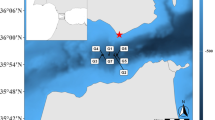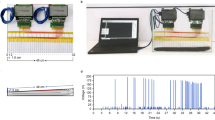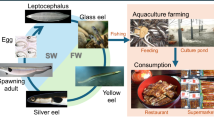Abstract
THE ingenious hypothesis proposed by Dr. D. W. Tucker1 to explain the complex problems of the biology of the European eel presents in my opinion some heavy difficulties. I believe it therefore necessary to offer some observations with the intention of clarifying the question.
This is a preview of subscription content, access via your institution
Access options
Subscribe to this journal
Receive 51 print issues and online access
$199.00 per year
only $3.90 per issue
Buy this article
- Purchase on SpringerLink
- Instant access to full article PDF
Prices may be subject to local taxes which are calculated during checkout
Similar content being viewed by others
References
Tucker, D. W., Nature, 183, 495 (1959).
Schnakenbeck, W., Zool. Anz., 108, 85 (1934).
D'Ancona, U., Riv. Biol., 43, 171 (1951).
D'Ancona, U., Arch. Ocean. Limnol., 3, 159 (1943).
Carlisle, D. B., and Denton, E. J., J. Mar. Biol. Assoc., 38, 97 (1959).
Schmidt, J., “Danish Eel Investigations” (Copenhagen, 1932).
Schmidt, J., Phil Trans. Roy. Soc., B, 211, 179 (1922).
Author information
Authors and Affiliations
Rights and permissions
About this article
Cite this article
D'ANCONA, U. Old and New Solutions to the Eel Problem. Nature 183, 1405 (1959). https://doi.org/10.1038/1831405a0
Issue date:
DOI: https://doi.org/10.1038/1831405a0
This article is cited by
-
Swimming physiology of European silver eels (Anguilla anguilla L.): energetic costs and effects on sexual maturation and reproduction
Fish Physiology and Biochemistry (2010)
-
The European eel (Anguilla anguilla, Linnaeus), its Lifecycle, Evolution and Reproduction: A Literature Review
Reviews in Fish Biology and Fisheries (2005)
-
Genetic control and variability of phosphoglucose isomerase (PGI) in eels from the Atlantic ocean and the Mediterranean Sea
Marine Biology (1977)
-
Haemoglobin Polymorphism of the American Fresh Water Eel Anguilla
Nature (1967)
-
The Atlantic Eel Problem
Nature (1960)



